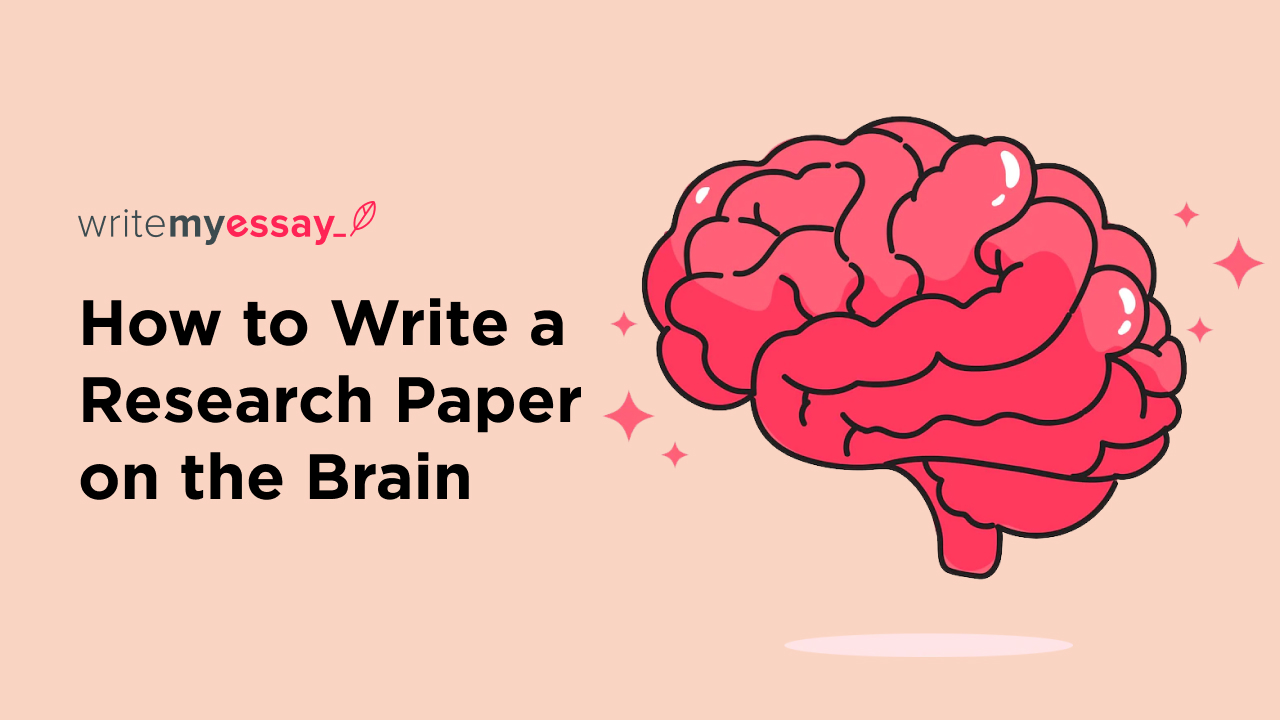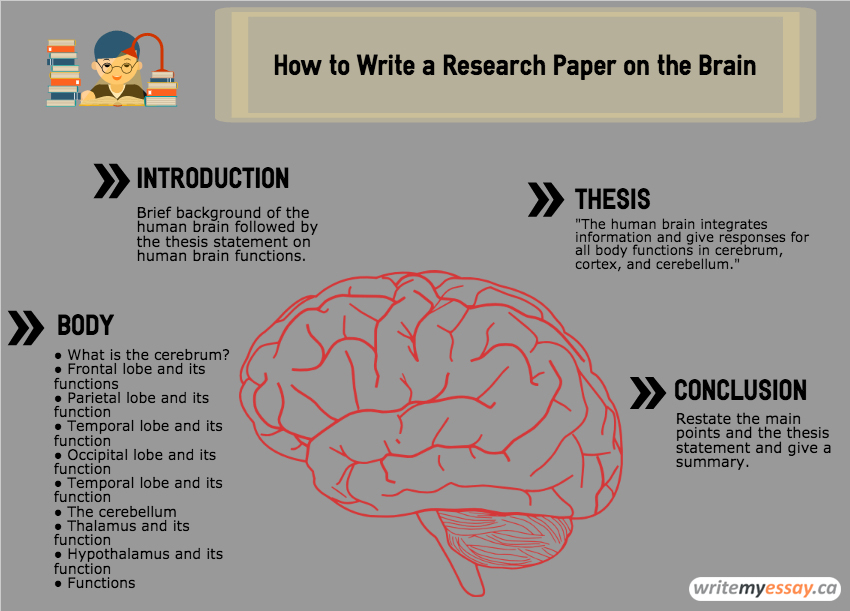
How to Write a Research Paper on the Brain

Table of Contents
Research Paper on the Brain
- How to start a research paper on the brain
- Tips on how to start
- Example of an outline
- Example of a thesis
- Example of an introduction
- How to write body paragraphs for a research paper on the brain
- Tips on body writing
- Example of the first body paragraph
- Example of the second body paragraph
- Example of the third body paragraph
- How to finish a research paper on the brain
- Tips on conclusion writing
- Example of a conclusion
- Tips on research paper revision

How to start a research paper on the brain
Writing a research paper is quite challenging and tedious. Some students even give up in their research work due to the time the research activity consumes while others have no clue on the best procedures to follow. Thus, the students fail in their final grade. Don’t you think it is time to change the negative attitude and delve into research techniques that enable you to score A+ in your research papers? We know you want to make your final grade to be tremendous and gain experience as well as excellence in the research. Therefore, you should follow the bellow writing techniques of a research paper.
Students usually struggle to put ideas, energies, and skills to deliver a perfect research paper. However, as they get ready for action, their mental goes blank. Hence they remain with dump founded with no information to write on the blank page. Thus, students should follow the guide below for the construction style and the best format for your paper. Besides, you will be able to avoid mistakes and pitfalls when writing such papers.
Tips on how to start
- Students should select an exciting topic on the brain
- Research information about the topic from newspapers, books, journals, internet.
- Writer should make a specific thesis statement on the topic
- Draft an outline for the research paper
- The student should then organize all the notes gathered during the research
- Student should write his or her first draft
- Revise the draft and the outline
- Writer should then type the final paper
Example of an outline
Topic: Human Brain Functions
INTRODUCTION
- Brief background of the human brain followed by thesis statement on human brain functions
BODY
- Cerebrum – what is it?
- Frontal lobe and its functions
- Parietal lobe and its function
- Temporal lobe and its function
- Occipital lobe and its function
- Temporal lobe and its function
- The cerebellum
- Thalamus and its function
- Hypothalamus and its function
- Functions
CONCLUSION
- Analytical summary
- Thesis reiteration
- Concluding statement
Example of a thesis
Human brain integrates information and give responses for all body functions in cerebrum, cortex, and cerebellum.
Example of an introduction
Do you know that you have no function without your brain? The brain forms part of the nervous system for communication and decision making. Everybody part of a person is connected to the brain that coordinates their functions every moment. For example, there is part of the brain that controls breathing, blinking, walking and talking among others. The different organs of the body connect to the brain via nerves for linkage and communication. Thus, the significant parts of the brain that control such functionality include forebrain, midbrain, and hindbrain. The human brain integrates information and gives responses for all body functions in cerebrum, cortex, and cerebellum.
How to write body paragraphs for a research paper on the brain
The bulk of the research paper is in the body of the essay. Therefore, students should emphasize on informative writing that gives the reader the relevant information regarding the topic and thesis statement. The student should follow the outline to build the body around the main points. Besides, ensure that all the information is integrated with the source in the discussion. Furthermore, provide proper analysis and evaluation on your paper with a coherency that indicates a shift from generalization to different levels of details. To achieve such information, students should follow the below tips.
Tips on body writing
- Write the main idea in a sentence form
- Note down the supporting points for the idea
- Elaborate on the points in a descriptive manner
- Provide pieces of evidence and examples to support the position
- Summarize the idea in the paragraph
- Follow the same procedure for different ideas in separate paragraphs
- Link the paragraphs using transitions to the thesis statement
Example of the first body paragraph
The cerebrum is the significant part of the brain and is responsible for actions and thoughts. The cerebrum is divided into four portions performing different functions. For example, frontal lobe section is responsible for emotions, reasoning, speeches, movement, and problem-solving abilities as well as planning. Separately, the parietal lobe helps in movement, recognition, stimuli perceptions and orientation. The occipital lobe assists in the visual processing while the temporal lobe aids in recognition, auditory stimuli, and speech and memory activities.
Example of the second body paragraph
The cerebellum forms the analogous to the cerebrum. The portion of the brain has two hemispheres. Cerebellum helps in the regulation and coordination of movements, posture, and balance. Besides, it has the amygdala that allows an emotional response, arousal, and secretions of hormones and control of fear responses. On a separate note, the cerebellum has thalamus that has numerous regions. The thalamus translates the information that is read in the cerebral cortex.Besides, thalamus helps in the regulation of sleep and wakefulness and consciousness. Furthermore, it regulates the arousal levels, awareness levels, and activities and results to a permanent coma when it faces injuries.
Example of the third body paragraph
The hypothalamus is under the thalamus and helps in homeostasis. Therefore, the part of the brain helps in control of body temperatures, body weight, blood pressure, fluid-electrolyte balance to set points. Besides, the hypothalamus is the center of control for the automatic regulation of body activities, endocrine system, cardiovascular organs and the visceral organs. Furthermore, the section helps in the coordination of sensory processing, control of body metabolism, ingestion and hormonal levels. Elsewhere, the hypothalamus is responsible for the pituitary activities, control of complex emotions, feelings, and moods. Furthermore, it relays motivational states such as hunger, appetite, intake of foods, pleasure, comfort, creative activities and satisfaction. On the same note, it enhances the integration of all the physiological stimulation, smell, touch, sight, taste and sounds and then translates such to distinctive package and concept to memory. Therefore, hypothalamus performs most of the necessary activities of our daily feelings or endeavors including resting.
How to finish a research paper on the brain
When writing a conclusion of a research paper, students should not whether the presentations are complex. Therefore, they need to provide a useful summary for the reader to understand the topic. Ensure that you explain the significance of the discussion and add your points up to elaborate on the significance. Furthermore, shift from the detailed to general level to bring back the topic to the present context elaborated in the introduction. Lastly, give the reader the next step to follow such as a need for further study among others. Therefore, the following tips will guide a writer in the successful completion of a conclusion.
Tips on conclusion writing
When writing a conclusion, authors note that it is the part that they leave with the reader. Therefore, students should
- Summarize the paper
- Restate the main point and thesis statement
- Give a summary of the different points in body of the research paper
- Provide the reader with a well thought final impression
Example of a conclusion
In a nutshell, the brain is a major portion of the nervous system that performs numerous functions. Indeed, all the activities that happen within or outside the human body are coordinated in the brain before they take actual effect. The integration of all the information and responses in the human body take place due to the brain. Such functions are performed in different locations of the brain such as the cerebrum, cerebellum, and hypothalamus.
Tips on research paper revision
After completing a research paper, students should read the draft and give it to a colleague to read it. Therefore, students easily note the different mistakes and spelling errors. Besides, writers should follow the following tips to revise the research paper.
- Check the outline of the draft and make it simple
- Run the research essay on spell-checking software to correct spelling, grammar errors,
misused words and spacing errors - Use the correct format as provided in the instructions
- Read the draft aloud and correct the errors
- Give the essay to a friend or a family member to read and correct the mistakes


